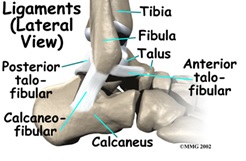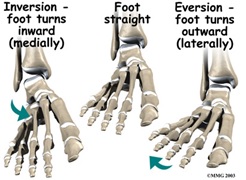Anatomy
What part of the ankle is involved?
Ligaments are tough bands of tissue that help connect bones together. Three ligaments make up the lateral ligament complex on the side of the ankle farthest from the other ankle.

They are the anterior talofibular ligament (ATFL), the calcaneofibular ligament (CFL), and the posterior talofibular ligament (PTFL). The common inversion injury to the ankle usually involves two ligaments, the ATFL and CFL. Normally, the ATFL keeps the ankle from sliding forward, and the CFL keeps the ankle from rolling inward on its side.
Causes of Ankle Sprains
Why do I have this problem?

- A sprain results in stretching or tearing of the ligaments. Minor sprains only stretch the ligament. A tear may be either a complete tear of all the strands of the ligament or a partial tear of only some of the strands. The ligament is weakened by the injury; how much it is weakened depends on the degree of the sprain.
- A severe form of ankle sprain, called an ankle syndesmosis injury, involves damage to other supportive ligaments in the ankle. This type of injury is sometimes called a high ankle sprain because it involves the ligaments above the ankle joint.
Symptoms of Ankle Sprains
- Initially the ankle is swollen, painful, and may be bruised.
- People who have sprained an ankle often end up spraining the ankle again. If the ankle keeps turning in with activity, the condition is called ankle instability. Patients who have ankle instability lose confidence in their ankle to support them, especially on uneven ground. They often have swelling around the ankle that doesn’t go away.
Diagnosis of an Ankle Sprain
The diagnosis of an ankle sprain is usually made by examination of the ankle. An X-ray or MRI may be required to make sure that the ankle is not fractured or ankle ligaments torn. A physical examination is used to determine which ligament has been injured. The doctor will move your ankle in different positions in order to check the ligaments and other soft tissues around the ankle. If a complete rupture of the ligaments is suspected, your doctor may order stress X-rays as well. These X-rays are taken while the ligaments are placed in a stretched position. The X-ray will show a slight tilt in the ankle bone if the ligaments have been torn.
Ankle Sprain Treatment
The best results after an ankle sprain come when treatment is started right away. Consult us immediately. Treatments are used to stop the swelling, ease pain, and protect how much weight is placed on the injured ankle.
- Swelling and pain are treated with specialised soft tissue, electrical stimulation and ultrasound.
- We also apply specialized hands-on treatment called joint mobilization to improve normal joint motion. These treatments restore the gliding motion within the ankle joint where the lower leg meets the talus bone. This form of treatment speeds healing after an ankle sprain, and it helps return people and players more quickly to their activity or sport.
- Your Doctor may also prescribe Platelet Rich Plasma or Prolotherapy in order to heal torn structures. This will help to reduce pain and inflammation to stimulate healing. Healing of the ligaments usually takes about six weeks. PRP or Prolotherapy will help you regain full range of ankle motion, improve balance, and maximize strength.
Ankle Instability Treatment
If the ankle ligaments do not heal adequately, you may end up with ankle instability. This can cause the ankle to give way and feel untrustworthy on uneven terrain. If your ankle ligaments do not heal adequately following an ankle sprain, your osteopath may suggest several things.
- Clinical Pilates will likely be initiated to help restore joint range of motion, strength, and joint stability. Small nerve sensors inside the ligament are injured when a ligament is stretched or torn. These nerve sensors give your brain information about the position of your joints, a sensation called position sense. For example, nerve sensors in your arm and hand give you the ability to touch your nose when your eyes are closed. The ligaments in the ankle work the same way. They send information to your nervous system to alert you about the position of your ankle joint. We will help you retrain this sensation as a way to steady the ankle joint and protect you from spraining your ankle again.
- Platelet Rich Plasma or Prolotherapy is used to help with ankle instability.

